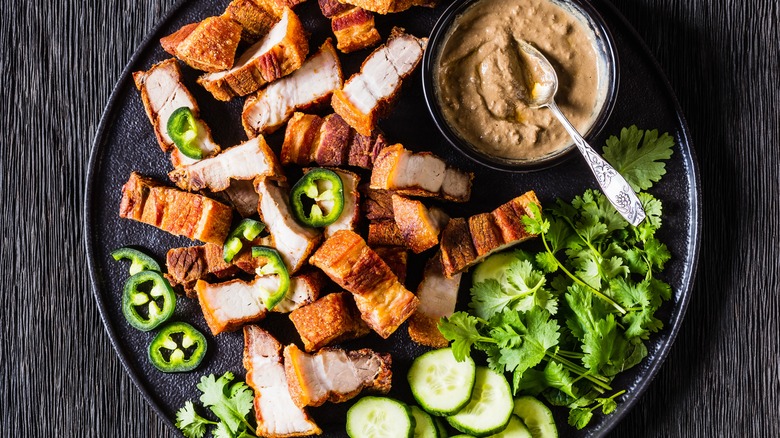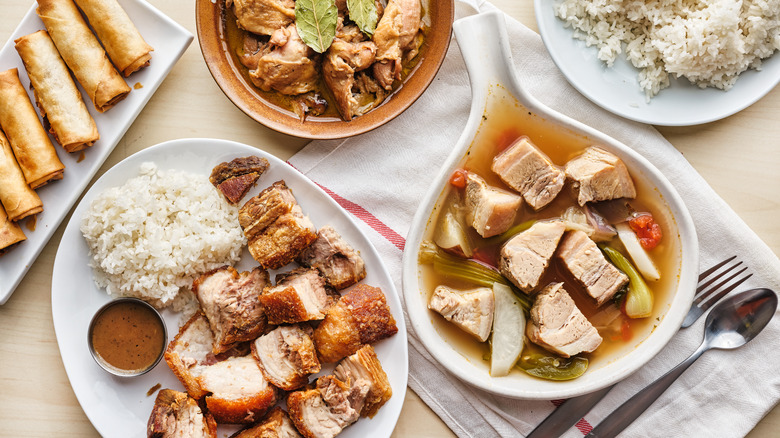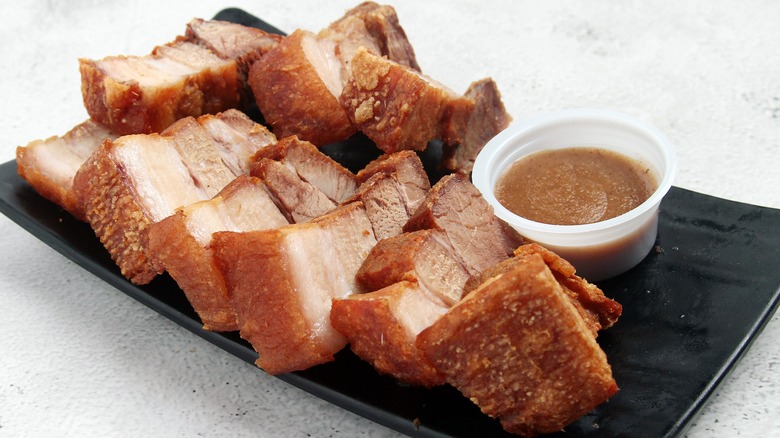The Secret To Crispy And Flavorful Filipino Fried Pork Belly
You're seated in a Filipino eatery, and per the server's enthusiastic recommendation, you've ordered lechon kawali — a plate of golden-brown fried pork belly that glistens invitingly. With each bite, you savor crackling, crispy skin and a tender, juicy meaty layer. It's no wonder lechon kawali is one of the most beloved and iconic dishes in the Philippines, often known as the country's national dish.
Enjoying lechon kawali, you can't help but wonder: "How do they achieve this perfect crispiness?" The secret to that perfect crispy skin is to first boil the pork belly in salted and seasoned water for around 30 minutes. Then, similar to making Chinese roasted pork (or siu yuk, 燒肉), you'd want to air-dry the cooled boiled pork, uncovered, for anywhere from a few hours to overnight in the refrigerator. Afterward, you'd cut the pork belly into cubes or 2-inch thick slices and deep-fry until the skin crackles to perfection.
While there are noticeable parallels between lechon kawali and Chinese roast pork, distinct differences exist. Chinese roast pork is not typically deep-fried, incorporating salt and five-spice powder for seasoning. The crispy skin characteristic of the Chinese variant also arises from a different meticulous process involving a vinegar bath followed by a salt layer during the roasting phase.
Lechon kawali's rich history
When unraveled to its core, Filipino fried pork belly, or lechon kawali, encapsulates the essence of Filipino cuisine. The term "lechón" is a Spanish word meaning "roasted pig," reflecting the era of Spanish colonization in the Philippines, while "kawali" is a Tagalog word signifying a frying pan. Thus, lechon kawali translates to pan-roasted or pan-fried pork, with its name offering a direct window into how it's made and the historical influences that shaped it. Each bite is a rich, juicy, crispy taste of history and tradition.
Historically treated as a centerpiece at significant Filipino gatherings and celebrations, lechon kawali today is a ubiquitous delight, frequently featured in Filipino restaurants across the U.S. Its widespread popularity is unsurprising — this dish is as palatable and crave-able as it is Instagrammable. Across social media, you can find food influencers running knives through the pork's crispy skin or enjoying it with different sauces, such as vinegar mixed with soy sauce, chiles, spices, or even with guacamole.
Boil pork belly first and fry not-too-thin slices for perfect results
Looking to master lechon kawali's crispy magic at home? Starting with the raw pork belly, season it with salt. In a pot filled with enough water to submerge the pork belly, you can add salt, pepper, garlic, bay leaves, and soy sauce. This seasoned water will permeate deep into the pork belly as it boils, making the meat flavorful, tender, and well-prepped for deep-frying later.
The boiling process takes about 30 minutes. Then — as mentioned — you'll want to cool the pork belly and air-dry it, uncovered, in the refrigerator overnight to remove any excess moisture on the surface. Dry pork belly ensures that when the pork hits the hot oil, it'll crisp up beautifully rather than steaming from residual water, which results in a disappointingly mushier texture.
Prior to frying or deep-frying, you'll want to cut the pork belly into slices — not too thick so the pork cooks through, but thick enough so the meat remains juicy and each bite comes with enough crispy skin. Around 2-inch slices are a good place to start, depending on your chosen piece of meat. Once they've been rested for a few minutes after frying, all that's left is to enjoy your heavenly meal of lechon kawali.


